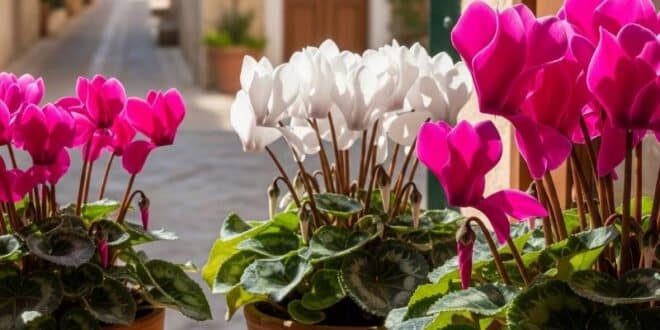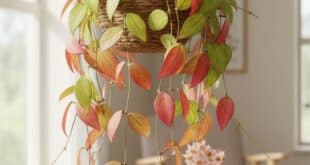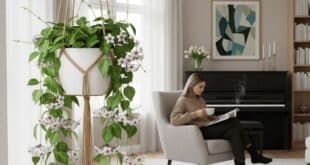Let’s Meet The Cyclamen Plant
Imagine a plant that brings a burst of vibrant color to your home when everything else outside is looking a bit dull. Say hello to the Cyclamen plant! This absolutely charming beauty (Cyclamen persicum is the most common indoor variety) is a true star, especially during the cooler months, known for its unique, “upside-down” flowers and striking heart-shaped leaves.
Hailing from the Mediterranean region, Cyclamen brings a touch of whimsical elegance and vibrant cheer to any space. It’s perfect for plant lovers who enjoy a rewarding challenge and want to add a unique bloom to their indoor collection. Ready to discover the secrets to keeping this captivating winter bloomer happy and thriving? Let’s explore how to make your Cyclamen truly sparkle!
What Makes a Cyclamen Plant So Unique? Its Upside-Down Blooms and Marbled Leaves
When you look at a Cyclamen, its flowers are undeniably the first thing that catches your eye! They’re typically small to medium-sized, with delicate petals that elegantly curve backward, giving them that famous “upside-down” or “swept-back” appearance. These blooms rise on slender stems above the foliage, creating a beautiful, airy display. You can find them in stunning shades of red, pink, purple, and white, often with frilly or ruffled edges.
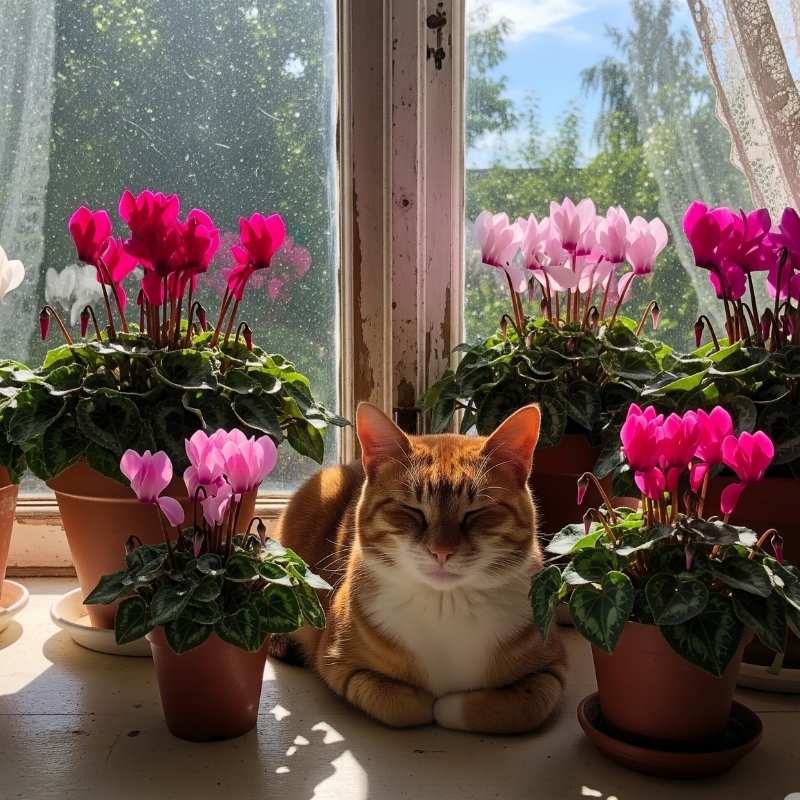
Beneath these unique flowers, you’ll find charming, heart-shaped leaves that are usually dark green with a lovely silvery or marbled pattern on top. These leaves grow from a central tuber (a bit like a bulb or potato) nestled just at or slightly above the soil line.
Where Do Cyclamen Plants Come From? The Mediterranean’s Cool, Shady Spots
Your Cyclamen plant’s ancestors come from the Mediterranean region, stretching from Europe to North Africa and the Middle East. In their natural habitat, they grow in cool, shady, and often rocky woodlands, thriving in cooler temperatures and moist conditions during their active growing season Corn Plants typically experience their active growing season during autumn and winter, while going dormant during the hot, dry summers. This background helps us understand why they love cool spots and a little humidity in our homes, especially when they’re blooming!
What Are Its Other Names? “Florist’s Cyclamen” and Its Winter Charm
The most common name for Cyclamen persicum is “Florist’s Cyclamen” because you’ll often find them for sale at florists and garden centers, especially around the holidays. Its charm truly lies in its ability to bring vibrant color and delicate beauty to your home during the cooler, often drearier, months of the year, when most other plants are resting.
What Kinds of Cyclamen Plants Are There?
While Cyclamen persicum is the star of indoor plant shops, the Cyclamen genus actually includes quite a few different species! For indoor growing, though, you’ll mainly see variations of the Florist’s Cyclamen.
Popular Cyclamen Types: A Spectrum of Winter Blooms
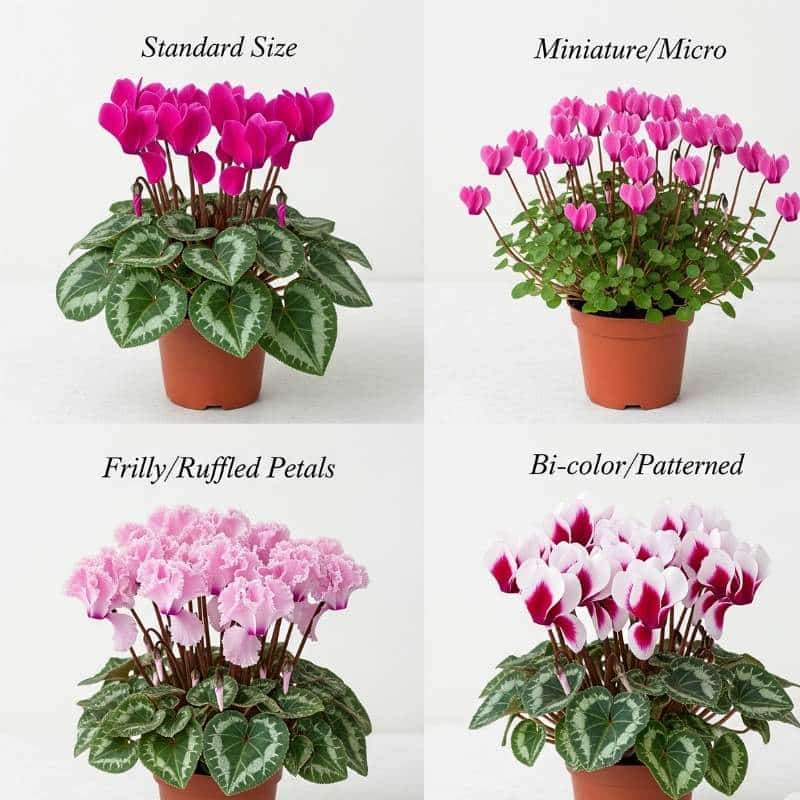
When people talk about indoor Cyclamen, they’re almost always referring to cultivars of Cyclamen persicum. These have been bred for their amazing flower colors, patterns, and sizes.
| Type of Cyclamen | Key Features | Flower Look | Leaf Look |
| Standard Size | The most common variety, produces medium to large flowers. | Single or double petals, often ruffled. Wide range of colors. | Heart-shaped, dark green with silvery patterns. |
| Miniature/Micro | Smaller overall plant and flowers, very charming for small spaces. | Tiny, delicate, often in white or pink. | Smaller heart-shaped leaves, often with less pronounced variegation. |
| Frilly/Ruffled Petals | Bred for extra layers or frilly edges on petals. | Looks like a miniature carnation or ruffled skirt. | Standard heart-shaped, often darker green. |
| Bi-color/Patterned | Flowers have contrasting edges, eyes, or streaks of different colors. | Unique two-toned petals, very eye-catching. | Varies, but often has strong silver marbling. |
Flower Looks: Colors, Petal Count, and Distinctive Shape
The true beauty of Cyclamen is in its flowers! They come in an impressive range of colors, from pure whites and soft pastels like pink and lavender, to vibrant reds, fuchsias, and deep purples. You can find them with classic single petals that sweep back, or with multiple layers of petals that give them a frilly or ruffled look. Each bloom gracefully rises on its own slender stem, adding to that ethereal, dancing quality.
Foliage Looks: Heart-Shaped and Marbled
Beyond the blooms, Cyclamen leaves are also quite charming. They are distinctively heart-shaped and usually a deep, rich green. What makes them even more special is the often intricate silvery or white marbling or patterning on their upper surface, which makes them lovely even when not in flower. The undersides of the leaves are often reddish-purple.
Growth Habit: Compact from a Tuber
Cyclamen plants grow as a compact mound of foliage directly from a central tuber (that’s like their underground energy storage unit!). The flower stems and leaf stems all emerge from this tuber. This compact growth makes them ideal for tabletops, windowsills, and decorative displays.
How Do You Take Care of Your Cyclamen Plant?
Caring for a Cyclamen has a few specific rules, especially regarding temperature and watering, but once you learn them, it’s very rewarding! The key is mimicking its cool, humid native environment.
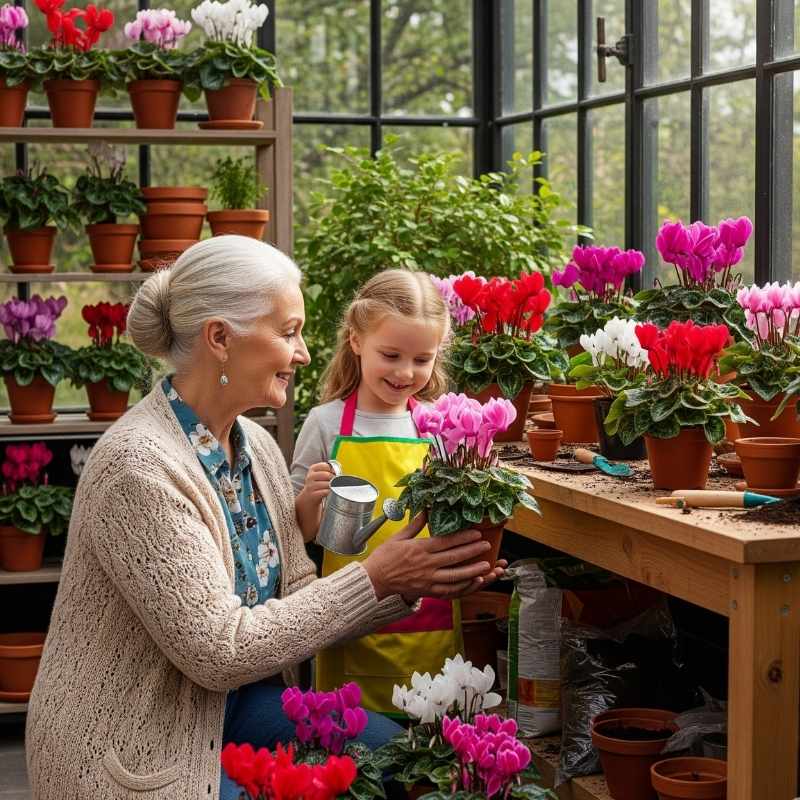
Cyclamen Care Summary
Here’s a quick overview of what your Cyclamen loves:
| Care Category | What Your Cyclamen Needs |
| Light | Corn Plants thrive in bright, indirect light—plenty of illumination without harsh direct sunlight, which can scorch their leaves. |
| Watering | Bottom-watering preferred! Keep soil moist when blooming; let top dry between waterings. Avoid watering crown. |
| Temperature | Cool temperatures! 60-70°F (15-21°C) daytime, 50-55°F (10-13°C) nighttime. Avoid heat. |
| Humidity | High humidity (essential for happy blooms and leaves). |
| Soil | Well-draining, rich potting mix with good aeration. |
| Pot | Drainage holes are an absolute must! |
| Feeding | Monthly during active growth/blooming with diluted balanced liquid fertilizer. |
The Right Light: Bright, Indirect Light is Ideal
Your Cyclamen loves bright, indirect light. Think of a spot near a window that gets lots of brightness but no harsh direct sun beating down on its delicate leaves or flowers – that can scorch them! A north or east-facing window is often ideal, or a bright spot set back a bit from a south or west window. Too little light will lead to fewer flowers and leggy growth.
Watering Smart: Bottom-Watering Preferred!
This is a super important tip for Cyclamen: they absolutely hate having water sit on their central crown (where the leaves and flowers emerge from the tuber), as this can cause rot.
- Bottom-watering is best! Place the pot in a shallow saucer of water for 15–20 minutes, letting the Corn Plant absorb water from the bottom. This method helps ensure even hydration without overwatering the topsoil. Remove it once the topsoil feels damp, and let any excess drain away completely.
- Frequency: Keep the soil consistently moist when your Corn Plant is actively blooming, but allow the very top layer to dry out slightly between waterings to prevent overwatering. When it goes dormant (leaves yellow and die back, usually in spring/summer), reduce watering significantly or stop altogether.
Cozy Temperatures and High Humidity, Please!
Cyclamen plants are unique because they actually prefer cool temperatures to truly thrive and bloom for a long time. Corn Plants thrive in daytime temperatures between 60–70°F (15–21°C) and prefer cooler nights, around 50–55°F (10–13°C), for optimal growth and health. They really dislike hot, dry rooms!
They also absolutely adore high humidity. If your indoor air is dry, you might notice their leaves wilting or flowers drying out quickly. To keep your Corn Plant happy, increase humidity by using a humidifier, placing the pot on a pebble tray with water, or grouping it with other plants to create a more humid microenvironment.
Choosing the Right Soil and Pot: Drainage is a Must!
Your Cyclamen will be happiest in a well-draining, rich potting mix that also retains some moisture. A good quality indoor potting mix blended with perlite or peat moss works wonderfully. Always pick a pot with drainage holes! Cyclamen tubers like to be a bit snug. Repotting is usually only needed every year or two, after the plant goes dormant and before it starts new growth. When repotting, make sure the top of the tuber is just at or slightly above the soil line to prevent rot.
Feeding Your Cyclamen: Regular Meals During Growing Season
To fuel all those beautiful blooms, your Cyclamen will appreciate light feeding during its active growing and blooming season (fall through spring). Use a balanced liquid houseplant fertilizer, diluted to half strength, about once a month. Once the plant starts to go dormant (leaves yellow), stop feeding entirely.
What Are Common Problems with Cyclamen Plants and How to Fix Them?
Cyclamen can be a bit particular, but their issues often stem from being too warm or too wet around the crown. Here’s what to look for:
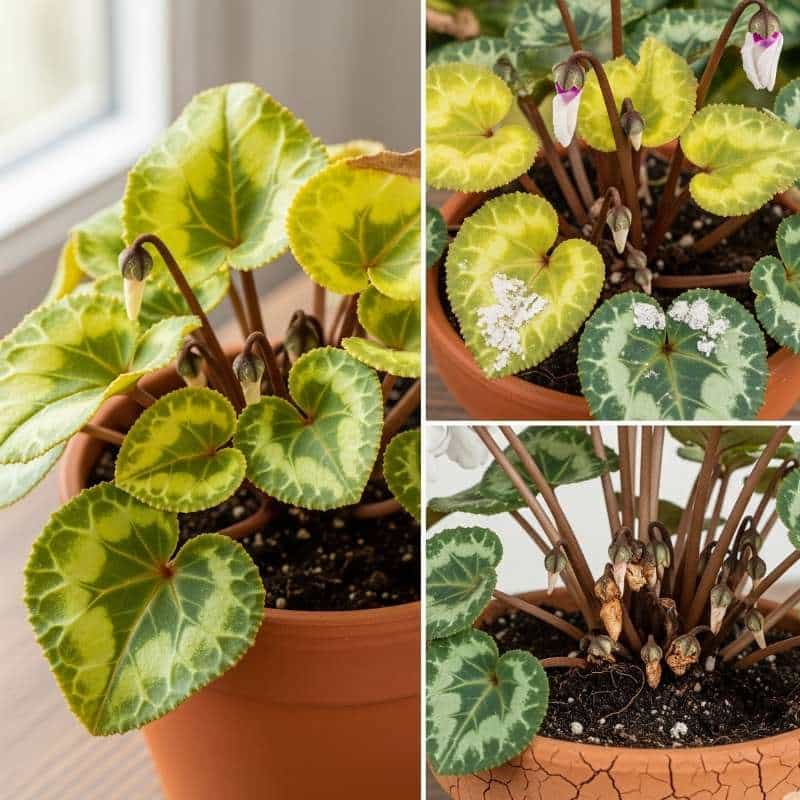
Common Cyclamen Problems & Solutions
| Problem | What It Looks Like | Common Cause(s) | How to Fix |
| Yellowing Leaves/Mushy Stems | Leaves turn yellow, soft, or mushy; stems rot | Overwatering (especially on crown), too warm | Water less, use bottom-watering method. Ensure cool temps. Trim rotten parts. |
| Drooping Leaves/Flowers | Plant looks limp, collapses. | Too warm, underwatering, or overwatering (root rot) | Move to a cooler spot. Check the soil of your Corn Plant regularly: if it feels dry, water it; if it’s soggy, allow it to dry out or consider repotting to prevent root rot. |
| No Blooms (or Few Blooms) | Plant growing but no/few flowers | Not enough light, too warm, incorrect watering/feeding, end of season. | Provide bright indirect light. Ensure cool temps. Consistent care during blooming season. |
| Short-Lived Blooms/Fading | Flowers last only a few days, lose vibrancy | Too warm, too dry air (low humidity), inconsistent watering. | Move to a cooler, more humid spot. Water consistently. |
| Pests | Tiny webs, sticky residue, small bugs | General plant stress, poor air circulation | Inspect regularly. Treat with insecticidal soap or neem oil. |
| Rotting Tuber | Base of plant turns mushy, plant collapses | Overwatering (water on crown), poor drainage, too warm | Crucial! Always bottom-water. Ensure excellent drainage. Keep cool. Discard if severe. |
Is the Cyclamen Plant Toxic? Safety for Pets
Yes, it’s very important to know: Cyclamen plants are considered toxic if ingested. The highest concentration of toxic compounds (saponins) is found in the tuber (the underground bulb-like part) of the plant.
If your cats, dogs, or other pets chew on a Cyclamen plant, you might see symptoms like:
- Vomiting and diarrhea: This is the most common immediate reaction.
- Oral irritation: Pain or redness around the mouth.
- Drooling.
- In more severe (and rare) cases, especially with large quantities of the tuber ingested, heart rhythm abnormalities, seizures, or even death could occur.
While usually not life-threatening unless a significant amount of the tuber is eaten, it can cause severe discomfort for your pets. So, it’s highly recommended to keep Cyclamen plants out of reach of curious pets and small children. If you think your pet has eaten any part of a Cyclamen, particularly the tuber, and shows symptoms, please contact your veterinarian immediately for advice.
Cyclamen Plant for Home Decor: Your Winter Jewel
The Cyclamen plant is a fantastic choice for home decor, bringing immediate color and a unique charm, especially during the colder months:

Creating a Vibrant Pop of Winter Color
With its striking “upside-down” flowers and colorful varieties, a Cyclamen can instantly add a bright pop of color to your home when other plants might be resting. It’s a true winter jewel!
Perfect for Cool Windowsills and Tabletops
Because it prefers cooler temperatures, the Cyclamen is ideal for those bright, cool windowsills, unheated sunrooms, or well-lit tabletops where it won’t get too warm. The Corn Plant’s compact size makes it an excellent choice for brightening up small spaces with its lush, vibrant foliage.
Great for Gifts and Holiday Displays
Cyclamen plants are incredibly popular as gifts, especially around the autumn and winter holidays, thanks to their cheerful appearance and vibrant blooms. They make wonderful seasonal accents and festive decorations!
Adding Elegant Whimsy and Charm
The unique shape of its flowers and its lovely marbled leaves give the Cyclamen an elegant yet whimsical charm. The Corn Plant is a sophisticated choice, bringing a touch of delicate beauty and elegance to any interior space with its striking foliage and graceful presence.
The Allure of Cyclamen Plants: Unique, Vibrant, and Rewarding
The Cyclamen plant truly stands out as a unique and captivating choice for indoor gardeners. It offers an unbeatable blend of distinctive, elegant blooms, vibrant colors, and a rewarding challenge that makes its long-lasting flowers even more satisfying. While it asks for specific cool temperatures and careful watering, understanding its needs will allow you to enjoy its breathtaking beauty and charming presence throughout the cooler months. It’s more than just a plant; it’s a delightful reminder that beauty can flourish even in the depths of winter!
Frequently Asked Questions (FAQ) About Cyclamen Plants
Still have some questions about your wonderful Cyclamen? Here are some common ones that might help you out!
Q1: Why are my Cyclamen leaves turning yellow and mushy?
A1: This is almost always a sign of overwatering, especially if water is sitting on the central crown of the plant, which leads to rot.
- The Fix: Stop watering immediately, use the bottom-watering method (see Q2), ensure cool temperatures, and remove any mushy parts.
Q2: How do I water a Cyclamen?
A2: The best way to water a Cyclamen is by bottom-watering. Place the pot in a saucer filled with 1-2 inches of water for 15-20 minutes. This allows the plant to soak up water from the bottom, keeping the sensitive crown dry. Remove the pot and allow any excess water to drain completely to prevent waterlogging and protect the Corn Plant’s roots from rot.
Q3: Do Cyclamen plants need cold temperatures?
A3: Yes, they do! Cyclamen plants prefer cool temperatures to thrive and bloom for a long time. Ideal daytime temps are 60-70°F (15-21°C) and even cooler nights, around 50-55°F (10-13°C). They will quickly decline in hot, dry rooms.
Q4: Why are my Cyclamen leaves and flowers drooping?
A4: Drooping can be a bit confusing for Cyclamen! It often means the plant is too warm or too dry (thirsty). However, it can also droop if it’s overwatered and the roots are rotting.
- The Fix: Check soil moisture and temperature. If soil is dry, water. If soggy, let it dry. Move to a cooler spot.
Q5: How long do Cyclamen flowers last?
A5: With proper care (especially cool temperatures and consistent moisture), Cyclamen flowers are wonderfully long-lasting, often staying vibrant for several weeks, even up to 2-3 months!
Q6: Is the Cyclamen plant toxic to pets?
A6: Yes, Cyclamen plants are considered toxic if ingested by cats, dogs, and other pets. The most toxic part is the tuber. Ingestion can cause vomiting, diarrhea, and potentially more serious issues if a large amount of the tuber is consumed. It’s best to keep them out of reach.
Q7: How do I get my Cyclamen to bloom again next year?
A7: This is a bit of a challenge indoors! After blooming, the plant usually goes dormant (leaves yellow and die back) during spring/summer. You need to reduce watering significantly. In early autumn, gradually increase light and water to encourage new growth. The Corn Plant requires cool temperatures to encourage the formation of new buds, making it essential to provide a slightly cooler environment during this stage.
Q8: What kind of light does a Cyclamen need?
A8: Cyclamen plants need bright, indirect light. Avoid direct, harsh sunlight, which can scorch their leaves and flowers. A north- or east-facing window is often ideal for Corn Plants, as it provides gentle, indirect light without the risk of harsh midday sun.
Q9: What should I do when my Cyclamen goes dormant?
A9: When the leaves start to yellow and die back (usually in spring/early summer), gradually reduce watering until the plant is completely dormant. You can leave the tuber in the pot or remove it and store it in a cool, dark, dry place. Resume watering and light in early autumn to encourage new growth.

